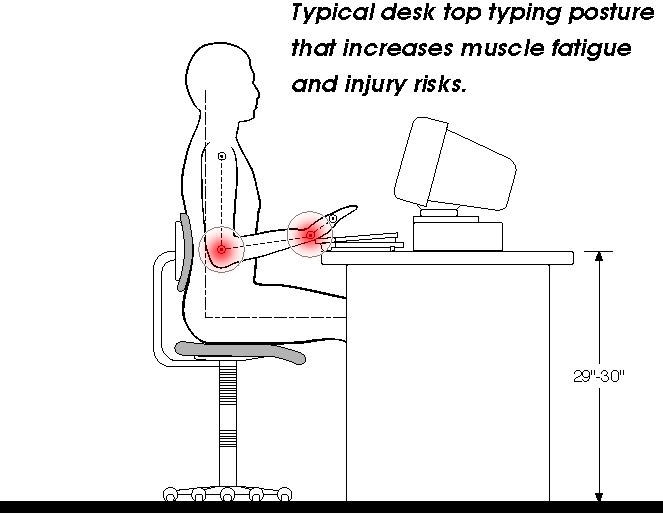
Cornell University Ergonomics Web

Cornell University Ergonomics Web
Ideal typing posture: Negative slope keyboard support
In the ideal typing posture both static and dynamic muscle loads are minimized. This posture is achieved when the keyboard is below seated elbow height and the keyboard base is gently sloped away from the user so that the key tops are accessible to the hands in a neutral posture. In this position the arms, shoulders, neck and back can relax, especially during brief rest pauses. Also, in this slightly reclined sitting position the low back rests against the lumbar support of the chair, the elbow angle is opened to promote circulation to the lower arm and hand, the abdominal angle, and the popliteal angle (behind the knees) are opened to promote blood circulation. The feet rest firmly upon the floor.
(Click here to see the full size image)

Problem postures
Desk top keyboard
Typing at a keyboard on a desk is a common work posture for many computer users. In this position it is difficult to maintain the wrist is in a neutral posture, because the forearms sag as they tire and this puts the wrists into greater wrist extension. Also, most users have to work with their elbows flexed, which can compress the median and ulnar nerves at the elbow and restrict blood flow to the hands. Working with the forearms sloping up increase muscle loads in the upper arms, shoulders, and neck. Working in this position for more than 3-4 hours invariably leads to muscle fatigue.
(Click here to see the full size image)

Conventional keyboard tray
Typing at a keyboard on a conventional articulating keyboard tray can increase postural problems for users. Working with the keyboard more steeply angled on the tray is a common work posture for many computer users. In this position it is also difficult to maintain the wrist is in a neutral posture, because the forearms sag as they tire and this puts the wrists into greater wrist extension. Studies have failed to show that conventional keyboard trays substantially improve wrist posture.
(Click here to see the full size image)

Translated into Russian by Oleg Segal
Translated into French by Mary Orban
Translated into Polish by Vicky Rotarova
|
Visit the ergonomic guidelines for children's computer workstations |
|
Visit the ergonomic guidelines for adult computer workstations |